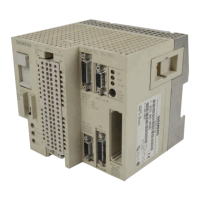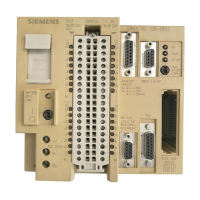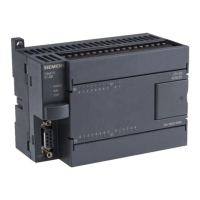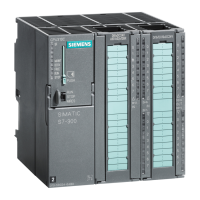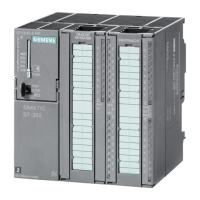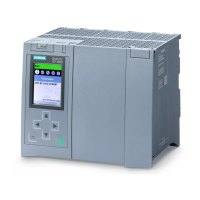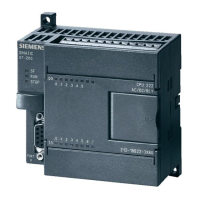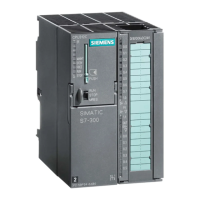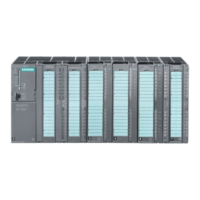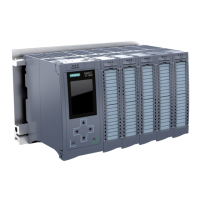Do you have a question about the Siemens SIMATIC S5-115F and is the answer not in the manual?
Guides the reader on how to use the manual effectively and describes its contents across two volumes.
Details the primary industrial fields where the S5-115F programmable controller is utilized.
Outlines the safety classes and quality levels the S5-115F meets for official approval.
Describes the modular components that constitute the S5-115F system, including PS, CPU, I/O, and interface modules.
Explains how to expand the system's capacity using expansion units (EUs) via centralized or distributed configurations.
Details the communication facilities offered by the S5-115F, including SINEC L1 LAN and programmer connections.
Covers how the S5-115F interfaces with operators for process visualization and programming tasks.
Discusses the software aspects of the S5-115F, including the STEP 5 programming language.
Explains the hardware design of the S5-115F, featuring two-channel redundancy for enhanced reliability and safety.
Describes the S5-115F system's modular design, composed of various functional units combined to suit specific problems.
Explains how the programmable controller processes user programs, detailing functional units like memory, processor, and I/O bus.
Lists accessories that can optimize the programmable controller's expansion degree, such as backup batteries and memory submodules.
Details the various mounting racks available for the S5-115F system, their construction, and module slot numbering.
Covers the mechanical aspects of installing modules, including fastening, slot coding, and adapter casings.
Explains the electrical connections required for the S5-115F system, including power supply, sensors, actuators, and front connectors.
Details the electrical installation of the S5-115F, including power supply, field devices, and grounding concepts.
Provides measures to suppress interference and ensure electromagnetic compatibility (EMC) during controller installation.
Describes wiring arrangements for bus cables, signal cables, and power supply cables to guarantee electromagnetic compatibility.
Explains the importance and methods of equipotential bonding for ensuring proper functioning of electronic components.
Details measures for shielding cables to weaken magnetic, electric, or electromagnetic interference fields.
Covers arc suppression elements for inductive circuits and measures for suppressing noise from fluorescent lamps.
Provides essential information on operating the S5-115F programmable controller, including controls and LEDs.
Guides on configuring programmable controllers and putting the system into operation, including safety measures.
Explains the structure of digital and analog module addresses, including bit and byte addressing.
Details how to assign addresses to slots using interface modules or fixed addressing methods.
Describes how to read and write input/output module signal states using process images (PII, PIQ) or direct access.
Presents the CPU RAM map, illustrating the memory areas and their assignments for the CPU 942 F.
Explains how to program process interrupts using the digital input module and the involved OBs and FBs.
Details the characteristics and types of analog input modules, including the 460 and 463 modules.
Provides pin assignments and sensor connection details for the 460-7LA12 analog input module.
Covers connecting sensors and installing the front connector for the 463-4U analog input module.
Explains how analog values are represented digitally in the 460 analog input module, including bits for measured value and status.
Describes methods for detecting wire-breaks in analog signals using hardware, FB 250 ANEI, or user programs.
Explains the method of operation for analog output modules, covering conversion and data transfer.
Illustrates how analog values are represented in digital form for output channels, explaining the bits and their meaning.
Classifies I/O module types based on safety-related aspects, signal characteristics, and connection types.
Explains how function blocks FB 250 and FB 251 match nominal ranges to standard ranges for analog modules.
Introduces the communication capabilities of the S5-115F, including SINEC L1 LAN and programmer use.
Describes the SINEC L1 LAN system for networking SIMATIC S5 controllers, including master-slave principle and transceiver requirements.
Details nonsafety-related connections for transmitting input/output data and process visualization between master and slave S5-115F PLCs.
Explains safety-related networking for multiple S5-115Fs, covering message protection and mailbox structures.
Describes how to integrate S5 PLCs of the U range into safety-related networks as SINEC L1 slaves.
Explains how to achieve safety-related and fault-tolerant networking using two SINEC L1 LANs for increased system availability.
Describes how programmers connect to the S5-115F CPU and their functions for program testing and error diagnostics.
Details the CP 523 serial I/O module, its functions in print and communications modes, and its connection requirements.
Lists the climatic and mechanical environmental conditions for operating the S5-115F system, including temperature, humidity, and vibration.
Provides detailed descriptions and technical specifications for various S5-115F modules, including mounting racks, power supply, CPU, and I/O modules.
Lists accessories such as adapter casings and front connectors that enhance the S5-115F system's functionality and usability.
Defines reliability and explains how failure rate is measured, providing a formula for calculation.
Defines availability and provides formulas for MTBF and MTTR, discussing measures to enhance availability.
Explains how the S5-115F is designed to prevent danger from hardware failures, focusing on safety-related actuators and hidden errors.
Details the implementation of safe inputs using two-channel input modules and the necessary comparison checks for failsafe operation.
Describes how safe binary outputs are implemented using dual-channel switching and the importance of readback for error detection.
Explains requirements for user memory configuration, including submodule compatibility and backup battery importance.
Describes the use of the logical program counter (LPLZ) for checking program section processing in both subunits.
Explains how to demonstrate specific response times for automation planning, considering various procedures and module delays.
Details the PLC cycle time as a safety variable, its relationship to response and safety times, and methods for estimation.
Explains the importance of synchronizing subunits using FB 254 SYNC and the monitoring of intervals for accuracy and transmission times.
Discusses the monitoring of I/O accesses for discrepancy times to detect hardware faults, covering short and long discrepancy times.
Outlines operations that must be limited or forbidden in STEP 5 programming to guarantee plant safety, including illegal memory access and operations.
Details different types of digital and analog I/Os, distinguishing between safety-related and nonsafety-related, and intermittent/non-intermittent signals.
Discusses configuring digital inputs, including sensor implementation and requirements for sensor signals.
Explains how to define I/O types for digital output modules based on process output signal characteristics and covers outputting commands to protective devices.
Guides on defining I/O types for analog input modules, specifying permissible types for safety-related use and requirements for sensors with current outputs.
Explains the method of operation for analog output modules, covering conversion and data transfer.
Explains the assignment of I/O types to unused digital words for 32-bit DI/DQ modules.
Guides on assigning I/O types to unused channels of AI/AQ modules, recommending the simplest I/O type.
Provides rules for permissible I/O type mixes within one I/O module, emphasizing not to mix safety-related and nonsafety-related types.
Explains byte and word addressing relationships and the address grid for I/O module addressing.
Details how the system responds to I/O module errors based on different error tolerance variants (ETVs) and signal group numbers.
Explains the process of I/O module passivation, its causes, results, and how it's handled by the operating system and user program.
Describes how to revoke passivation of I/O modules using FB 255, including calling procedures and parameter assignments.
Explains the operating system and user program responses to I/O errors based on error tolerance variants (ETVs) and signal groups.
Outlines the procedure for repairing passivated I/O modules, including test mode and safety mode resets.
Covers requirements for connecting and operating the programmer with the S5-115F, including SINEC L1 LAN connections.
Provides an overview of programmer functions available in safety mode, detailing operator entries and data input procedures.
Lists important points to note when operating a SINEC L1 LAN, including master configuration, data flow, and mailbox setup.
Explains the requirements and recommendations for creating a polling list for SINEC L1 LAN connections.
Discusses the SINEC L1 safety time, its dependency on automated processes, and methods to decrease it.
Explains the role of FB 254 SYNC in monitoring SINEC L1 LAN data traffic and synchronizing communication partners.
Covers operating the SINEC L1 LAN with two channels, including mailbox access and error handling with FB 253 MBXT.
Provides information to help prepare for the acceptance test of a safety-related system, focusing on failsafe interaction with components.
Details the connector pin assignments for various modules within the S5-115F system, including power supply, CPU, and interface modules.
States that S5-115F modules have undergone prototype tests and provides contact information for obtaining certificates.
Lists Siemens companies and representatives worldwide, categorized by region and country.
Guides the reader on how to use the manual effectively and describes its contents across two volumes.
Details the primary industrial fields where the S5-115F programmable controller is utilized.
Outlines the safety classes and quality levels the S5-115F meets for official approval.
Describes the modular components that constitute the S5-115F system, including PS, CPU, I/O, and interface modules.
Explains how to expand the system's capacity using expansion units (EUs) via centralized or distributed configurations.
Details the communication facilities offered by the S5-115F, including SINEC L1 LAN and programmer connections.
Covers how the S5-115F interfaces with operators for process visualization and programming tasks.
Discusses the software aspects of the S5-115F, including the STEP 5 programming language.
Explains the hardware design of the S5-115F, featuring two-channel redundancy for enhanced reliability and safety.
Describes the S5-115F system's modular design, composed of various functional units combined to suit specific problems.
Explains how the programmable controller processes user programs, detailing functional units like memory, processor, and I/O bus.
Lists accessories that can optimize the programmable controller's expansion degree, such as backup batteries and memory submodules.
Details the various mounting racks available for the S5-115F system, their construction, and module slot numbering.
Covers the mechanical aspects of installing modules, including fastening, slot coding, and adapter casings.
Explains the electrical connections required for the S5-115F system, including power supply, sensors, actuators, and front connectors.
Details the electrical installation of the S5-115F, including power supply, field devices, and grounding concepts.
Provides measures to suppress interference and ensure electromagnetic compatibility (EMC) during controller installation.
Describes wiring arrangements for bus cables, signal cables, and power supply cables to guarantee electromagnetic compatibility.
Explains the importance and methods of equipotential bonding for ensuring proper functioning of electronic components.
Details measures for shielding cables to weaken magnetic, electric, or electromagnetic interference fields.
Covers arc suppression elements for inductive circuits and measures for suppressing noise from fluorescent lamps.
Provides essential information on operating the S5-115F programmable controller, including controls and LEDs.
Guides on configuring programmable controllers and putting the system into operation, including safety measures.
Explains the structure of digital and analog module addresses, including bit and byte addressing.
Details how to assign addresses to slots using interface modules or fixed addressing methods.
Describes how to read and write input/output module signal states using process images (PII, PIQ) or direct access.
Presents the CPU RAM map, illustrating the memory areas and their assignments for the CPU 942 F.
Explains how to program process interrupts using the digital input module and the involved OBs and FBs.
Details the characteristics and types of analog input modules, including the 460 and 463 modules.
Provides pin assignments and sensor connection details for the 460-7LA12 analog input module.
Covers connecting sensors and installing the front connector for the 463-4U analog input module.
Explains how analog values are represented digitally in the 460 analog input module, including bits for measured value and status.
Describes methods for detecting wire-breaks in analog signals using hardware, FB 250 ANEI, or user programs.
Explains the method of operation for analog output modules, covering conversion and data transfer.
Illustrates how analog values are represented in digital form for output channels, explaining the bits and their meaning.
Classifies I/O module types based on safety-related aspects, signal characteristics, and connection types.
Explains how function blocks FB 250 and FB 251 match nominal ranges to standard ranges for analog modules.
Introduces the communication capabilities of the S5-115F, including SINEC L1 LAN and programmer use.
Describes the SINEC L1 LAN system for networking SIMATIC S5 controllers, including master-slave principle and transceiver requirements.
Details nonsafety-related connections for transmitting input/output data and process visualization between master and slave S5-115F PLCs.
Explains safety-related networking for multiple S5-115Fs, covering message protection and mailbox structures.
Describes how to integrate S5 PLCs of the U range into safety-related networks as SINEC L1 slaves.
Explains how to achieve safety-related and fault-tolerant networking using two SINEC L1 LANs for increased system availability.
Describes how programmers connect to the S5-115F CPU and their functions for program testing and error diagnostics.
Details the CP 523 serial I/O module, its functions in print and communications modes, and its connection requirements.
Lists the climatic and mechanical environmental conditions for operating the S5-115F system, including temperature, humidity, and vibration.
Provides detailed descriptions and technical specifications for various S5-115F modules, including mounting racks, power supply, CPU, and I/O modules.
Lists accessories such as adapter casings and front connectors that enhance the S5-115F system's functionality and usability.
Defines reliability and explains how failure rate is measured, providing a formula for calculation.
Defines availability and provides formulas for MTBF and MTTR, discussing measures to enhance availability.
Explains how the S5-115F is designed to prevent danger from hardware failures, focusing on safety-related actuators and hidden errors.
Details the implementation of safe inputs using two-channel input modules and the necessary comparison checks for failsafe operation.
Describes how safe binary outputs are implemented using dual-channel switching and the importance of readback for error detection.
Explains requirements for user memory configuration, including submodule compatibility and backup battery importance.
Describes the use of the logical program counter (LPLZ) for checking program section processing in both subunits.
Explains how to demonstrate specific response times for automation planning, considering various procedures and module delays.
Details the PLC cycle time as a safety variable, its relationship to response and safety times, and methods for estimation.
Explains the importance of synchronizing subunits using FB 254 SYNC and the monitoring of intervals for accuracy and transmission times.
Discusses the monitoring of I/O accesses for discrepancy times to detect hardware faults, covering short and long discrepancy times.
Outlines operations that must be limited or forbidden in STEP 5 programming to guarantee plant safety, including illegal memory access and operations.
Details different types of digital and analog I/Os, distinguishing between safety-related and nonsafety-related, and intermittent/non-intermittent signals.
Discusses configuring digital inputs, including sensor implementation and requirements for sensor signals.
Explains how to define I/O types for digital output modules based on process output signal characteristics and covers outputting commands to protective devices.
Guides on defining I/O types for analog input modules, specifying permissible types for safety-related use and requirements for sensors with current outputs.
Explains the method of operation for analog output modules, covering conversion and data transfer.
Explains the assignment of I/O types to unused digital words for 32-bit DI/DQ modules.
Guides on assigning I/O types to unused channels of AI/AQ modules, recommending the simplest I/O type.
Provides rules for permissible I/O type mixes within one I/O module, emphasizing not to mix safety-related and nonsafety-related types.
Explains byte and word addressing relationships and the address grid for I/O module addressing.
Details how the system responds to I/O module errors based on different error tolerance variants (ETVs) and signal group numbers.
Explains the process of I/O module passivation, its causes, results, and how it's handled by the operating system and user program.
Describes how to revoke passivation of I/O modules using FB 255, including calling procedures and parameter assignments.
Explains the operating system and user program responses to I/O errors based on error tolerance variants (ETVs) and signal groups.
Outlines the procedure for repairing passivated I/O modules, including test mode and safety mode resets.
Covers requirements for connecting and operating the programmer with the S5-115F, including SINEC L1 LAN connections.
Provides an overview of programmer functions available in safety mode, detailing operator entries and data input procedures.
Lists important points to note when operating a SINEC L1 LAN, including master configuration, data flow, and mailbox setup.
Explains the requirements and recommendations for creating a polling list for SINEC L1 LAN connections.
Discusses the SINEC L1 safety time, its dependency on automated processes, and methods to decrease it.
Explains the role of FB 254 SYNC in monitoring SINEC L1 LAN data traffic and synchronizing communication partners.
Covers operating the SINEC L1 LAN with two channels, including mailbox access and error handling with FB 253 MBXT.
Provides information to help prepare for the acceptance test of a safety-related system, focusing on failsafe interaction with components.
Details the connector pin assignments for various modules within the S5-115F system, including power supply, CPU, and interface modules.
States that S5-115F modules have undergone prototype tests and provides contact information for obtaining certificates.
Lists Siemens companies and representatives worldwide, categorized by region and country.
| Brand | Siemens |
|---|---|
| Model | SIMATIC S5-115F |
| Category | Controller |
| Language | English |
